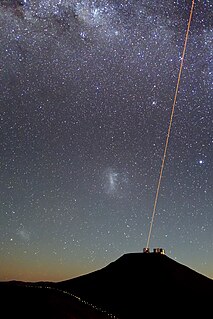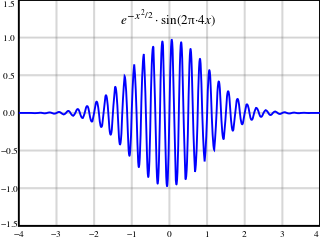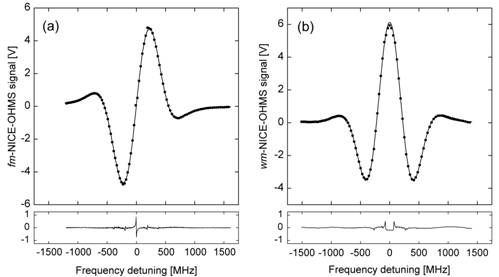
An optical amplifier is a device that amplifies an optical signal directly, without the need to first convert it to an electrical signal. An optical amplifier may be thought of as a laser without an optical cavity, or one in which feedback from the cavity is suppressed. Optical amplifiers are important in optical communication and laser physics. They are used as optical repeaters in the long distance fiberoptic cables which carry much of the world's telecommunication links.
Mode-locking is a technique in optics by which a laser can be made to produce pulses of light of extremely short duration, on the order of picoseconds (10−12 s) or femtoseconds (10−15 s). A laser operated in this way is sometimes referred to as a femtosecond laser, for example in modern refractive surgery. The basis of the technique is to induce a fixed-phase relationship between the longitudinal modes of the laser's resonant cavity. Constructive interference between these modes can cause the laser light to be produced as a train of pulses. The laser is then said to be 'phase-locked' or 'mode-locked'.
Tunable diode laser absorption spectroscopy (TDLAS) is a technique for measuring the concentration of certain species such as methane, water vapor and many more, in a gaseous mixture using tunable diode lasers and laser absorption spectrometry. The advantage of TDLAS over other techniques for concentration measurement is its ability to achieve very low detection limits. Apart from concentration, it is also possible to determine the temperature, pressure, velocity and mass flux of the gas under observation. TDLAS is by far the most common laser based absorption technique for quantitative assessments of species in gas phase.

Raman scattering or the Raman effect is the inelastic scattering of a photon by molecules which are excited to higher energy levels. The effect was discovered in 1928 by C. V. Raman and his student K. S. Krishnan in liquids, and independently by Grigory Landsberg and Leonid Mandelstam in crystals. The effect had been predicted theoretically by Adolf Smekal in 1923.
Cavity ring-down spectroscopy (CRDS) is a highly sensitive optical spectroscopic technique that enables measurement of absolute optical extinction by samples that scatter and absorb light. It has been widely used to study gaseous samples which absorb light at specific wavelengths, and in turn to determine mole fractions down to the parts per trillion level. The technique is also known as cavity ring-down laser absorption spectroscopy (CRLAS).
Here, is a list of initialisms and acronyms used in laser physics, applications and technology.
Ultrafast laser spectroscopy is a spectroscopic technique that uses ultrashort pulse lasers for the study of dynamics on extremely short time scales. Different methods are used to examine dynamics of charge carriers, atoms and molecules. Many different procedures have been developed spanning different time scales and photon energy ranges; some common methods are listed below.

Resonance-enhanced multiphoton ionization (REMPI) is a technique applied to the spectroscopy of atoms and small molecules. In practice, a tunable laser can be used to access an excited intermediate state. The selection rules associated with a two-photon or other multiphoton photoabsorption are different from the selection rules for a single photon transition. The REMPI technique typically involves a resonant single or multiple photon absorption to an electronically excited intermediate state followed by another photon which ionizes the atom or molecule. The light intensity to achieve a typical multiphoton transition is generally significantly larger than the light intensity to achieve a single photon photoabsorption. Because of this, a subsequent photoabsorption is often very likely. An ion and a free electron will result if the photons have imparted enough energy to exceed the ionization threshold energy of the system. In many cases, REMPI provides spectroscopic information that can be unavailable to single photon spectroscopic methods, for example rotational structure in molecules is easily seen with this technique.
A fiber laser or fibre laser is a laser in which the active gain medium is an optical fiber doped with rare-earth elements such as erbium, ytterbium, neodymium, dysprosium, praseodymium, thulium and holmium. They are related to doped fiber amplifiers, which provide light amplification without lasing. Fiber nonlinearities, such as stimulated Raman scattering or four-wave mixing can also provide gain and thus serve as gain media for a fiber laser.

In optics, a frequency comb is a laser source whose spectrum consists of a series of discrete, equally spaced frequency lines. Frequency combs can be generated by a number of mechanisms, including periodic modulation of a continuous-wave laser, four-wave mixing in nonlinear media, or stabilization of the pulse train generated by a mode-locked laser. Much work has been devoted to the latter mechanism, which was developed around the turn of the 21st century and ultimately led to one half of the Nobel Prize in Physics being shared by John L. Hall and Theodor W. Hänsch in 2005.
A distributed feedback laser (DFB) is a type of laser diode, quantum cascade laser or optical fiber laser where the active region of the device contains a periodically structured element or diffraction grating. The structure builds a one-dimensional interference grating and the grating provides optical feedback for the laser. This longitudinal diffraction grating has periodic changes in refractive index that cause reflection back into the cavity. The periodic change can be either in the real part of the refractive index, or in the imaginary part. The strongest grating operates in the first order - where the periodicity is one-half wave, and the light is reflected backwards. DFB lasers tend to be much more stable than Fabry-Perot or DBR lasers and are used frequently when clean single mode operation is needed, especially in high speed fiber optic telecommunications. Semiconductor DFB lasers in the lowest loss window of optical fibers at about 1.55um wavelength, amplified by Erbium-doped fiber amplifiers (EDFAs), dominate the long distance communication market, while DFB lasers in the lowest dispersion window at 1.3um are used at shorter distances.
Optical heterodyne detection is a method of extracting information encoded as modulation of the phase, frequency or both of electromagnetic radiation in the wavelength band of visible or infrared light. The light signal is compared with standard or reference light from a "local oscillator" (LO) that would have a fixed offset in frequency and phase from the signal if the latter carried null information. "Heterodyne" signifies more than one frequency, in contrast to the single frequency employed in homodyne detection.
Anthony E. Siegman was an electrical engineer and educator concerned with masers and lasers. He was president of the Optical Society of America in 1999 and was awarded the Esther Hoffman Beller Medal in 2009.
Gas in scattering media absorption spectroscopy (GASMAS) is an optical technique for sensing and analysis of gas located within porous and highly scattering solids, e.g. powders, ceramics, wood, fruit, translucent packages, pharmaceutical tablets, foams, human paranasal sinuses etc. It was introduced in 2001 by Prof. Sune Svanberg and co-workers at Lund University (Sweden). The technique is related to conventional high-resolution laser spectroscopy for sensing and spectroscopy of gas, but the fact that the gas here is "hidden" inside solid materials give rise to important differences.
Laser linewidth is the spectral linewidth of a laser beam.
In experimental atomic physics, saturated absorption spectroscopy or Doppler-free spectroscopy is a set-up that enables the precise determination of the transition frequency of an atom between its ground state and an optically excited state. The accuracy to which these frequencies can be determined is, ideally, limited only by the width of the excited state, which is the inverse of the lifetime of this state. However, the samples of atomic gas that are used for that purpose are generally at room temperature, where the measured frequency distribution is highly broadened due to the Doppler effect. Saturated absorption spectroscopy allows precise spectroscopy of the atomic levels without having to cool the sample down to temperatures at which the Doppler broadening is no longer relevant. It is also used to lock the frequency of a laser to the precise wavelength of an atomic transmission in atomic physics experiments.
The technique of vibrational analysis with scanning probe microscopy allows probing vibrational properties of materials at the submicrometer scale, and even of individual molecules. This is accomplished by integrating scanning probe microscopy (SPM) and vibrational spectroscopy. This combination allows for much higher spatial resolution than can be achieved with conventional Raman/FTIR instrumentation. The technique is also nondestructive, requires non-extensive sample preparation, and provides more contrast such as intensity contrast, polarization contrast and wavelength contrast, as well as providing specific chemical information and topography images simultaneously.

A distributed Bragg reflector laser (DBR) is a type of single frequency laser diode. Other practical types of single frequency laser diodes include DFB lasers and external cavity diode lasers. A fourth type, the cleaved-coupled-cavity laser has not proven to be commercially viable. VCSELs are also single frequency devices. The DBR laser structure is fabricated with surface features that define a monolithic, single mode ridge waveguide that runs the entire length of the device. A resonant cavity is defined by a highly reflective DBR mirror on one end, and a low reflectivity cleaved exit facet on the other end. Within the cavity is a gain ridge portion, where current is injected to produce a single spatial lasing mode. The DBR mirror is designed to reflect only a single longitudinal mode. As a result, the laser operates on a single spatial and longitudinal mode. The laser emits from the exit facet opposite the DBR end. The DBR is continuously tunable over approximately a 2 nm range by changing current or temperature. The temperature coefficient is approximately 0.07 nm/K, and the current coefficient is approximately .003 nm/mA. DBR lasers are stable, low noise optical sources. When operated with a low noise power supply at constant temperature, edge emitting DBR lasers have a linewidth of less than 10 MHz. Power levels typically can run up to several hundred milliwatts.
Vernier spectroscopy is a type of cavity enhanced laser absorption spectroscopy that is especially sensitive to trace gases. The method uses a frequency comb laser combined with a high finesse optical cavity to produce an absorption spectrum in a highly parallel manner. The method is also capable of detecting trace gases in very low concentration due to the enhancement effect of the optical resonator on the effective optical path length.






